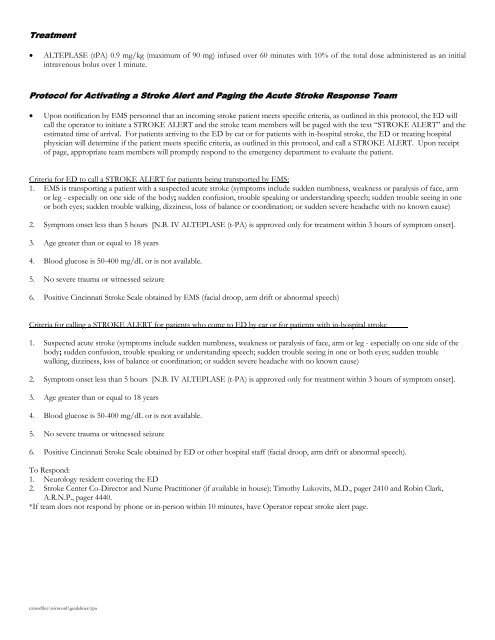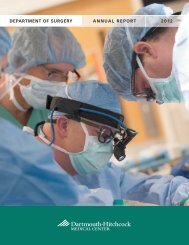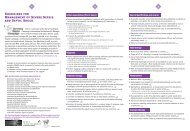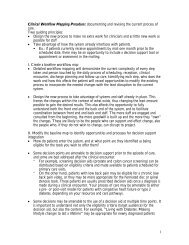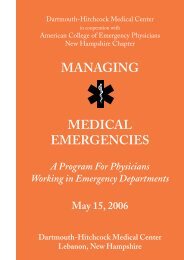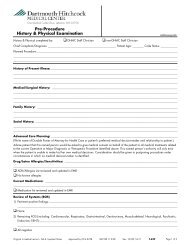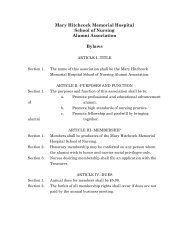Guideline for the Use of Intravenous ALTEPLASE (t-PA)
Guideline for the Use of Intravenous ALTEPLASE (t-PA)
Guideline for the Use of Intravenous ALTEPLASE (t-PA)
You also want an ePaper? Increase the reach of your titles
YUMPU automatically turns print PDFs into web optimized ePapers that Google loves.
Treatment• <strong>ALTEPLASE</strong> (t<strong>PA</strong>) 0.9 mg/kg (maximum <strong>of</strong> 90 mg) infused over 60 minutes with 10% <strong>of</strong> <strong>the</strong> total dose administered as an initialintravenous bolus over 1 minute.Protocol <strong>for</strong> Activating a Stroke Alert and Paging <strong>the</strong> Acute Stroke Response Team• Upon notification by EMS personnel that an incoming stroke patient meets specific criteria, as outlined in this protocol, <strong>the</strong> ED willcall <strong>the</strong> operator to initiate a STROKE ALERT and <strong>the</strong> stroke team members will be paged with <strong>the</strong> text “STROKE ALERT” and <strong>the</strong>estimated time <strong>of</strong> arrival. For patients arriving to <strong>the</strong> ED by car or <strong>for</strong> patients with in-hospital stroke, <strong>the</strong> ED or treating hospitalphysician will determine if <strong>the</strong> patient meets specific criteria, as outlined in this protocol, and call a STROKE ALERT. Upon receipt<strong>of</strong> page, appropriate team members will promptly respond to <strong>the</strong> emergency department to evaluate <strong>the</strong> patient.Criteria <strong>for</strong> ED to call a STROKE ALERT <strong>for</strong> patients being transported by EMS:1. EMS is transporting a patient with a suspected acute stroke (symptoms include sudden numbness, weakness or paralysis <strong>of</strong> face, armor leg - especially on one side <strong>of</strong> <strong>the</strong> body; sudden confusion, trouble speaking or understanding speech; sudden trouble seeing in oneor both eyes; sudden trouble walking, dizziness, loss <strong>of</strong> balance or coordination; or sudden severe headache with no known cause)2. Symptom onset less than 5 hours [N.B. IV <strong>ALTEPLASE</strong> (t-<strong>PA</strong>) is approved only <strong>for</strong> treatment within 3 hours <strong>of</strong> symptom onset].3. Age greater than or equal to 18 years4. Blood glucose is 50-400 mg/dL or is not available.5. No severe trauma or witnessed seizure6. Positive Cincinnati Stroke Scale obtained by EMS (facial droop, arm drift or abnormal speech)Criteria <strong>for</strong> calling a STROKE ALERT <strong>for</strong> patients who come to ED by car or <strong>for</strong> patients with in-hospital stroke1. Suspected acute stroke (symptoms include sudden numbness, weakness or paralysis <strong>of</strong> face, arm or leg - especially on one side <strong>of</strong> <strong>the</strong>body; sudden confusion, trouble speaking or understanding speech; sudden trouble seeing in one or both eyes; sudden troublewalking, dizziness, loss <strong>of</strong> balance or coordination; or sudden severe headache with no known cause)2. Symptom onset less than 5 hours [N.B. IV <strong>ALTEPLASE</strong> (t-<strong>PA</strong>) is approved only <strong>for</strong> treatment within 3 hours <strong>of</strong> symptom onset].3. Age greater than or equal to 18 years4. Blood glucose is 50-400 mg/dL or is not available.5. No severe trauma or witnessed seizure6. Positive Cincinnati Stroke Scale obtained by ED or o<strong>the</strong>r hospital staff (facial droop, arm drift or abnormal speech).To Respond:1. Neurology resident covering <strong>the</strong> ED2. Stroke Center Co-Director and Nurse Practitioner (if available in house): Timothy Lukovits, M.D., pager 2410 and Robin Clark,A.R.N.P., pager 4440.*If team does not respond by phone or in-person within 10 minutes, have Operator repeat stroke alert page.c:ms<strong>of</strong>fice\winword\guidelines\tpa


